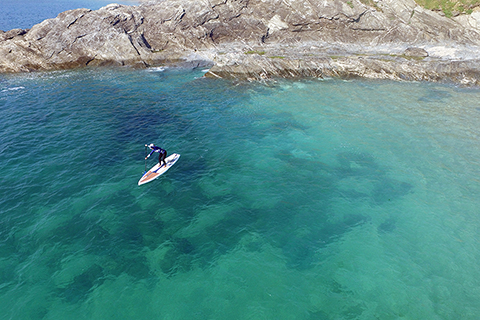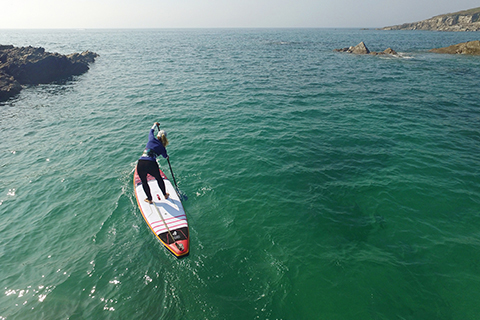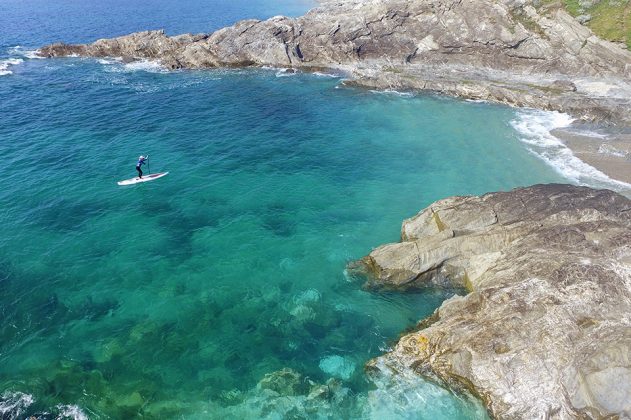PADDLE SCIENCE #5 –
MOVE IT OR LOSE IT
Supported by Kialoa Paddles
SUP is often credited for its numerous health and fitness benefits such as increased strength and core stability. Just the other day an article popped up which stated that SUP can give you unparalleled freedom of movement which is completely unrestricted. This of course is the ideal scenario. But, it is questionable as to whether or not many of us achieve or are even capable of achieving free and unrestricted movement whilst out on the water.
Firstly, what is movement? It’s a word that’s used all the time at the moment, enhanced by the surge in popularity of the fitbit and new apps which tell you how much activity you’re supposed to do all day, together with the recent trend in the Paleo diet to promote a more natural lifestyle. It’s likely that a greater awareness of movement and of moving more often is beginning to grow and take hold a little. However, a huge number of us exist in life doing little to no movement each day. If you don’t move much throughout the week and then jump on to your SUP board at the weekend, how free and unrestricted is your SUP session really going to be?
MOVEMENT IS CRITICAL TO HEALTH
In the world we live in we often have extreme periods of inactivity and often fail to move functionally. We are surrounded by an abundance of cars and lifts meaning our bodies are saved from any exertion such as walking. Instead of walking half a mile to the supermarket, we’re far more likely to drive and park right outside the front door. Rather than take the stairs, we often choose to take the lift. Even shopping trolleys now mean that we can effortlessly push our food in front of us rather than using our arms to carry it. Both vehicles and technology have developed in order to help us and make our lives easier.
However, through its creation, it has made things so much easier that we are now far less active and far more sedentary than we have ever been. This has become increasingly normal with a 20% reduction in physical activity in the UK over the past two generations.

// Kate parked at the far end of Sainsbury’s car park to prepare for this session.
Years ago, the homo sapiens was a hunter gatherer. We walked and ran long distances in pursuit of our next dinner. We used our bodies to climb, scrabble and jump over rocks and trees. We’d hunt, lift and carry our food and fetch our water. We’d swim in lakes and across rivers and haul wood to build a fire. Nowadays, due to modern conveniences, many functional movements seem to no longer be important. We are now able to ask why bother jumping? Or climbing? Or running a forest trail? These functional movements can suddenly seem pointless and foreign when we spend our days sitting at a desk, working on a computer in a nice ergonomically supportive seat. Typical days can involve getting out of bed, sitting to eat breakfast, sitting in the car on the drive to work before taking the lift to your office floor and sitting in the office at work for eight hours. You may get up and walk to the toilet or the kettle and back a few times but then it’s back to sitting – and no doubt, you sit to eat your lunch. At the end of the day – you’ve guessed it – more sitting as you drive home from work, then you sit to eat dinner, sit to watch some TV to relax – phew what an exhausting day – and then go to bed where you lie for hours before getting up and repeating the same process all over again.
Repeat this five times a week and it represents a pretty common pattern for many. At the weekend you may eagerly grab your SUP board and head to the water but after a week like this your strength, flexibility, joint mobility, proprioception and balance will likely be compromised.
Our bodies consist of an incredibly complex web of fascia, muscles, joints, ligaments, tendons, bones, connective tissue and organs. All of these components are interconnected and typically work together in complete synchrony. Our bodies are designed to enable us to perform highly complex, adaptable movements yet a sedentary lifestyle fails to challenge our bodies in any way. At what point in the week does it enable you to take your joints through their full range of motion? Load your body? Walk a decent distance? Challenge your balance? As we move less and use our bodies less, moving from one sedentary activity to another, it seems that we as a society have developed a huge level of detachment and disconnect from our bodies. How then, when you go paddling, can you expect your body to perform optimally if you haven’t moved naturally and functionally all week?
“As we move less and use our bodies less, moving from one sedentary activity to another, it seems that we as a society have developed a huge level of detachment and disconnect from our bodies ”
EXERCISE VERSUS MOVEMENT
With the best will in the world, many of us do try to break up the week by going for a couple of SUP sessions together with a few visits to the gym or a few runs outside each week. However, a large body of research indicates that exercising for a few hours here and there will not undo and overcome the negative effects of being sedentary the rest of the time. Indeed, research shows that intermittent vigorous exercise is unable to overcome the detrimental effects of sitting all day. Also consider the impact heavy exercise has on your body after remaining static for an entire day at work. Suddenly paddling out into surf or into resistance in a strong headwind and current for a couple of hours may feel good but it’s not the absolute key to better health. It requires your body to go from zero activity to high intensity all within a short period of time between leaving your workplace or home and putting on your wetsuit.
Additionally, outside of your water time, staying fit for SUP is common. This might include sprinting on a treadmill, high intensity interval training or performing weights with the aim of targeting your SUP muscles. However, exercising like this can not only stress your body, it’s often performed in a non-specific and non-functional way. Remember, the body is an interconnected unit. Therefore, focussing on only one muscle group during a workout is not always efficient. Using machines and isolated exercises to workout does not translate into an ability to lift your board on and off the roof of your car, to carry it down the beach, to haul yourself out of the water onto your board and to jump back into a surf stance when you catch a wave. Thus, whilst training for SUP via certain gym exercises can enhance your fitness it will not necessarily improve your ability to move functionally or practically when out on the water.
From the moment we are born, movement is incredibly important for enabling us to learn. Babies and children use movement extensively to promote learning which in turn optimises brain development. Our bodies are highly complex and are capable of a huge range of different movements. Every time you lift your board, stand on your board, paddle, jump into the water, climb back onto your board etc the soft tissues and joints in your body must work to keep you upright, bend, balance, stabilise, lift, pull, regulate your breathing and keep you moving. If you look at a wild animal, you’ll never see it exercising four times a week in an effort to just be active or to get into better shape. Animals don’t exercise to achieve an artificial objective, instead animals move in the way that they are supposed to. It isn’t a chore and the movement is natural. This is why movement, as opposed to exercise is important. Much research now points to the benefits of regular, daily movement rather than lone bouts of exercise to sustain good health.

// Move more, paddle better.
MOVE MORE EVERY DAY
The point of this article is not to say that paddling doesn’t help you to remain active or stay fit. Instead, the crux is that remaining sedentary for the majority of the week cannot be overcome by the odd SUP session or workout here and there. Furthermore, if you don’t move much all week, your body is unlikely to move optimally when you do get the chance to get out on the water. Start moving more naturally and introduce the following tips to increase your movement each and every day.
1. Lose the Chair. The quest for movement isn’t about never sitting down at all. It’s about making sure that you don’t sit for long periods of time. Make sure that every twenty minutes you get up, stand up and move. Also free up your joints and stretch your muscles out by sitting naturally. This can be squatting, crouching or sitting cross legged in an unsupported positon on the floor – anything than always opting for a supportive comfortable seat.
2. Forget Laziness. The next time you’re at the supermarket on a sunny day, rather than circling around the parking bays looking for a space close to the doors, park in an empty and distant part of the car park and walk. Even if you don’t feel like it, use what’s left of the light evenings to go for a walk or jog in the woods or along a coast path. Don’t choose being sedentary over increasing your daily movement.
3. Break Inactive Habits. Take the lift or the stairs? Drive to the shop or walk half a mile? Take the steps or climb over the rocks? Pull your board by its leash towards you or swim to it? Choose the most active way of getting somewhere or doing something and in no time at all you’ll naturally be moving more.
4. Take the Opportunity. Work movement into your day. Stand up and walk every time you make a phone call. Stretch your arms above your head every time you make a cup of tea. Be opportunistic with your movement. Move, move and then move some more.
5. Prioritise Movement. Not enough time to walk to work so you’ve just got to drive that one mile? Aim to leave the house half an hour earlier so that it gives you time to walk to work. If you prioritise your movement you are going a substantial way to prioritising your health.
You only have one body and this body is highly efficient. If you don’t move much, the body will make it easier for you to not move. However, if you do move, your body will allow you to move more. Your SUP sessions will feel easier and better as a result. SUP
Kate is a physiotherapist and standup paddler. Reach her at www.newquayphysio.co.uk


